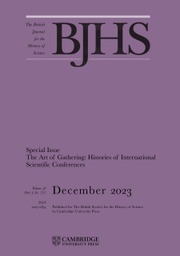Defining Nature's Limits contributes to an expanding field of scholarship that examines the relationship between religion and science in medieval and early modern Europe by re-evaluating how the Catholic Church shaped scientific knowledge. Neil Tarrant argues that ‘the inquisition of magic’ (p. 9), as he calls it, played an instrumental role in establishing the boundaries between orthodox and heterodox knowledge of the natural world. Although this demarcation arrived at a crucial crossroad with the establishment of the Roman Inquisition in the sixteenth century, Tarrant convincingly contends that one must venture into the Middle Ages to reveal its origins. By focusing on the Dominican order and its members’ primary role in the medieval and Roman inquisitions, he reconstructs the long history of intellectual debates around magic. He shows that a complex and multifaceted discussion over the status of what he calls the ‘operative arts’ – forms of learned magic such as astrology and geomancy – shaped the Church's approach to superstitious and heretical magic and influenced what came to be considered licit scientific knowledge.
The book's first part deals with the medieval origins of inquisitorial prosecution of magic. Tarrant situates it within the papacy's burgeoning attempts to fortify its power and enforce orthodoxy in Western Europe between the eleventh and fourteenth centuries. He shows how novel perceptions of learned magic as potentially heretical evolved with the Church's broader attempts to persecute heretics and how the papacy relied on the mendicant orders (including the Dominicans) to achieve this goal. The most significant argument advanced in this part of the book describes the emergence of a theoretical debate concerning the nature of the operative arts. Tarrant argues that, before the eleventh century, canon law largely portrayed magic as forbidden since it involved the intercession of demons. This notion was challenged in the thirteenth century by Dominican theologians, and most notably Thomas Aquinas, who proposed that learned magic was legitimate as long as its operation was natural and not demonic. According to Tarrant, this development changed both the understanding of learned magic and the focus of inquisitorial procedures: it rendered questionable not only the intent of practitioners, but even the operative arts themselves, whose innate functions became subject to inquisitorial scrutiny. This idea was not, however, promptly adopted by the Church and incorporated into inquisitors’ work. Fourteenth-century theologians, particularly the influential Dominican inquisitor Nicholas Eymerich, persisted in proscribing magic that involved forbidden ritualistic elements while misinterpreting Aquinas's works.
The book's second part studies the inquisition of magic in the fifteenth and sixteenth centuries. Tarrant once again positions this development within a renewed struggle for papal authority and the emergence of the Observant reform movement, which was central in efforts to purge society of superstition and heresy. He closely studies how Aquinas's imperative to investigate the natural boundaries of magic was adopted by theologians and inquisitors. Examining Italian inquisition trials, manuals and papal decrees, he nevertheless argues that the impact of these ideas remained limited and that inquisitors mostly continued to seek signs of diabolic rituals. This situation changed with the establishment of the Roman Inquisition in 1542. Focusing now on censorship, Tarrant detects Aquinas's influence in the Church's indices of forbidden books. Although the Thomist criteria for discerning the boundaries between natural and diabolic arts were manifested differently in the indices, in one way or another, they all pushed censors ‘to determine whether the effects produced by that art could be explained according to their understanding of the natural order’ (p. 197).
Defining Nature's Limits is a book of many merits. By overcoming the often artificial divide between the Middle Ages and the early modern period, Tarrant tells a compelling story about the Catholic Inquisition. His approach enables him to appreciate the centrality of medieval intellectual traditions for the development of the Roman Inquisition while offering an intriguing critique of scholars who he believes have overemphasized the influence of novel perceptions of diabolic witchcraft on the work of Italian inquisitors. Bridging the medieval divide also leads to his essential story, ‘an intellectual history of Thomist thought of magic’ (p. 18), whose evolution he tracks across centuries in an articulate, rich and nuanced manner.
The focus on Aquinas's heritage also leaves several important questions unanswered. Tarrant focuses more on how Thomist ideas were received and interpreted than on why. He situates their reception within the institutional power struggles and moments of political turmoil that motivated the growth of the inquisition; however, he does not provide a systematic study of the possible reasons why certain actors accepted Aquinas's approach toward the operative arts while others rejected it. He considers the influence of, for example, Christian humanism on perceptions of astrology in the individual case of Girolamo Savonarola. But he does not offer a broader analysis of the intellectual trends, popular beliefs and personal experiences that might have shaped theologians’ and inquisitors’ approach to the operative arts. Tarrant's powerful argument regarding the contribution of the inquisition of magic to the creation of the sciences arrives at a similar methodological obstacle. He does not show how the debates within the Church developed vis-à-vis contemporary scientific discussions over the boundaries of natural philosophy. In addition, he does not acknowledge that the inquisitors and censors involved in this story held intellectual and scientific commitments other than their religious (and apparently mostly Thomist) convictions, an approach to the study of censorship successfully demonstrated by Hannah Marcus in Forbidden Knowledge (2020), whose absence from Tarrant's work is puzzling.
Although the extent of the impact of the inquisition of magic on science thus remains unclear, this book, with originality, demonstrates how the Church sought the authority to define the limits of knowledge of the natural world. Its strength lies in showing how this process evolved over several centuries through the work of the mendicant orders, which makes it an invaluable contribution to the history of the inquisition.



